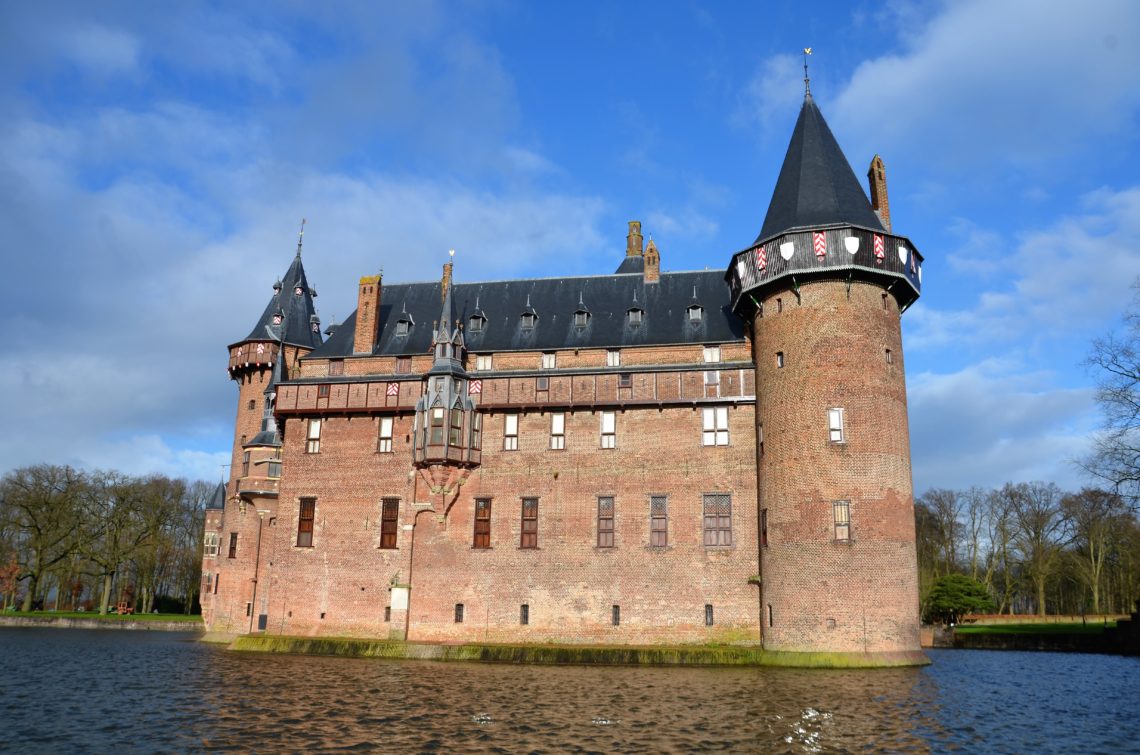
30 of the Most Beautiful Fairytale Castles in Europe
Europe has so much to offer when looking at stops on road trips, one of the things that should be on any itinerary are castles in Europe. Since there are so many, which are the best castles in Europe to stop at? I’ve asked my fellow travel bloggers which castles of Europe they find the most fairytale like and added a few of my favorites.
Castles in Europe
Without further ado here are 30 castles that are beautiful and worth your time.
Schloss Neuschwanstein, Germany
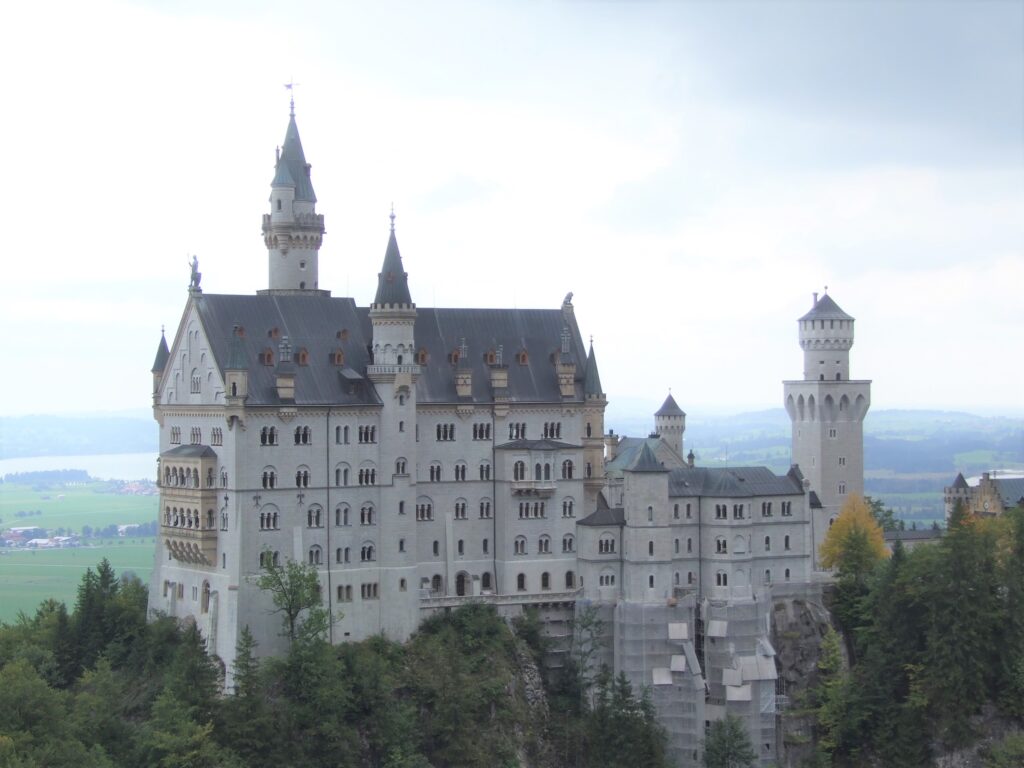
Contributed by Cosette from KarsTravels.
Neuschwanstein castle is the ultimate fairytale castle. The schloss is famous for being the inspiration behind Disneyland’s Sleeping Beauty Castle. It’s one of the most popular tourist destinations in Europe, and as such deserves a place on a 6 week European road trip.
The castle is located in the town of Hohenschwangau. Close to the border with Austria and near Füssen. King Ludwig II of Bavaria commissioned the construction of the castle in 1869. Ludwig II was befriended with Richard Wagner and loved his operas. His operas where an inspiration for the architecture of the castle together with the Romantic style.
The only way to visit the castle is to go on the 35-minute guided tour. Tickets cost €15.00 for adults and for free for anyone under 18. Reserve your tickets online or at the Ticket center in Hohenschwangau. They can’t be bought at the castle itself. Reserve about 3 hours for your visit, and take into consideration that you need time to find a parking space and walk to the castle.
The Mariënbrücke nearby gives a perfect view of Neuschwanstein. You’re not allowed to take photos from the inside. Peak season is from June till August. The castle receives about 1.5 million visitors a year.
Hluboká Castle, Czech Republic

Contributed by Martina & Jürgen from PlacesofJuma.
If you’re looking for a beautiful fairytale castle, the gorgeous neo-Gothic Hluboká Castle is a must-see on a trip to the Czech Republic. Located in southern Bohemia, about 30 kilometers from the famous medieval town of Ceský Krumlov, this stunning, snow-white castle is a true highlight of the country.
Particularly impressive is the detailed, snow-white facade as well as the many turrets that give Hluboká Castle a dreamlike ambience. During a tour of the complex, one walks through the picturesque rose gardens and almost feels like a princess from a fairytale. The castle is also interesting from the inside, where you can visit the magnificent 140 interior rooms.
The oldest part of the castle dates back to the 13th century, but the castle got its current form only in the middle of the 19th century, when Johann Adolf II of Schwarzenberg and his wife Eleonore had the castle completely rebuilt.
Hluboká Castle is best visited via a day trip from Prague or Ceský Krumlov! There are also various guided tours of the castle, which can be booked online. It is best to take 2 hours for your visit.
Opening hours are from 9am till 5pm. The admission is €8.00.
Burg Rheinfels, Germany

Contributed by Morgan from Crave the Planet.
The enchanting medieval castle of Burg Rheinfels inspires wonder and curiosity and sits within the UNESCO world heritage Rhine River Gorge in Germany. This castle is off the beaten path and less crowded than many other castles in the region. It’s located on the gorgeous Rhine Castle Trail that spans this gorgeous river gorge.
If you can book a stay at the Romantik Schloss Rheinfels, it’ll be a night you never forget. The castle also offers a museum, bookstore, cafe and restaurant.
Burg Rheinfels was built in 1245 and is nested above the half timbered village of Sankt Goar, Germany. It’s easy to reach from Frankfurt Airport via train, bus or car.
The tours are open Friday to Sunday 10:00 to 16:00. Admission fees: Admission is €6.00 for adults and children from 6 – 14 years are €3.00. Children up to 5 years are free. A family ticket with parents with their children is €13.00.
It’s perfect to pair with a visit to the other dozen or so castles in the immediate area, a wine tour or a fast ride at the Lorelei sommerrodelbahn.
Burg Eltz, Germany

Contributed by Kayla from Writing From Nowhere.
Prepare to step into a time machine on your visit to the Eltz Castle. Known locally as Burg Eltz, this medieval castle is located in the lush Wierschem, Germany. It’s still owned by the original family; the current generation is the latest link in a chain that dates all the way back to the 12th century. Having never been grazed by war, it seems untouched by time and is sure to transport you on your visit.
Stop for just a day, or stay to take in the surrounding Eltz Forest and Eltz National Park, home to the award-winning alluring hike: the Eltz Castle Panorama. You can enjoy the descent through the forest to the castle and explore the courtyard for free. Guided tours cost €10.00, with discounts available.
A tip for planning your visit: if you go in the darker months of the year, try to time your visit with the evening golden hour. It’s far less crowded and the castle glows magnificently in the sunset.
Schloss Hohenschwangau, Germany

Contributed by Cosette from KarsTravels.
Schloss Hohenschwangau is across from the more famous and aforementioned Neuschwanstein castle. Hohenschwangau is however equally beautiful and definitely worth your time. The castle is on a hill in the town of Hohenschwangau.
Hohenschwangau was built in the 12th century. However it was abandoned in the 16th century. In 1832 Crown Prince Maximilian of Bavaria bought the ruins and rebuilt it in 5 years. He choose to turn it into a romantic neo gothic style summer castle.
The enchanting castle has yellow outside walls with crenellation and 4 corner turrets. The interior of the castle is set in Biedermeier style. The symbol of the swan is ever present. There are over 90 wall paintings inside and they mostly depict German mythology.
You can’t park at the castle, you have to park in town (on parking lot P4). Then hike 20 minutes uphill or take a carriage to the castle entrance. The castle can only be visited on a 45-minute tour. Tickets can be bought online or at the Ticket center in the village. You can’t buy them at the castle itself. Prices are €21.00 for adults, kids 7 and up are €18.00.
Take at least 2 hours for a visit. Keep in mind that there’s no elevator in the castle. There are 90 steps in total in the castle.
Chenonceau, France

Contributed by Leyla from Offbeat France.
Chenonceau Castle is one of those romantic, dreamy castles one imagines when thinking of the Loire Valley – exquisite to photograph, and even better in person.
This 16th-century gem has a history steeped in romance. It was given by Henri II of France to his mistress, Diane de Poitiers. But his wife – Catherine of Medici – loved the castle and connived to get it back, which she finally did, upon her husband’s death. She sent the lovely Diane packing, and settled in for the duration. With good reason would Chenonceau come to be known as the Ladies’ Castle.
Catherine expanded its graceful bridge over the River Cher and built the famed two-storey gallery so admired by visitors. This was her party estate, and she never missed a chance to entertain, bringing in the first ever fireworks in France.
Chenonceau would eventually pass into other hands, but always with a story attached. During World War I, it would serve as a hospital for wounded soldiers and during World War II, the Cher River on which it sits would be the demarcation line in France between occupied and free zones. It would serve as a bridge for those wanting to escape the Nazis.
Chenonceau is one of the few Loire Valley chateaux to be right next to a train station, so getting there by public transport from Paris takes less than two hours – an easy day trip. Entrance costs €15.00 per adult, with discounts for children and seniors. A good three hours should be set aside for the visit, including not only the castle but the various gardens and dependencies.
Beaumaris Castle, Wales

Contributed by Annabel from Smudged Postcard.
Beaumaris Castle is located on the island of Anglesey in North Wales. It was built by Edward I of England in the 13th century. Taken from the French, Beau Mareys – meaning “fair marsh”. Visitors to the castle (on a clear day) have a spectacular view of the Menai Straits, the waterway which separates Anglesey from mainland Wales. Beyond the straits are the mighty mountains of Snowdonia offering a dramatic backdrop to the castle.
Beaumaris is known as the greatest castle never built – Edward I became distracted by new projects and left the castle unfinished. Despite this, the castle’s powerful defensive design and near-perfect symmetry are clear to see today.
The castle is surrounded by a moat. High walls can be walked along – which is great fun for children. In the inner courtyard there is a foam version of the castle which children can build and knock down.
There is a charge to enter the castle and while there is no guided tour, there is a useful film about the history of Beaumaris. There is plenty to admire at the castle and visits are likely to last around two hours. The castle is best reached by car, there is a large carpark next door along with a good children’s play area.
Beaumaris is without doubt one of the best things to do in Anglesey for families. There is an excellent café close by – Pier Café – which is perfect for lunch.
Alhambra, Spain

Contributed by Milijana from World Travel Connector.
There’s no doubt Alhambra Palace in Granada is the most famous castle in Spain.
Even more, Alhambra is the most famous tourist attraction in Spain. It is the most visited site in Spain that gets 2 million visitors a year.
Visiting Alhambra is one of the must-have experiences in Spain. Stunning Alhambra is known as one of the most beautiful castles in the world. Alhambra Palace in Granada in Southern Spain is a Moorish architectural jewel built during the Al Andalus era in the 8th century. The palace complex is known for the exquisite Nasrid Palaces with magnificent Patio of the Lions, lovely Generalife Palace with Gardens, beautiful Comares Palace with Court of the Myrtles, Palace of Carlos V, and the Alcazaba fort.
Alhambra Palace in Granada is a must-see World Heritage Site. Daily visits to Alhambra are limited. The visitors are allowed to visit Alhambra in time slots. That’s why a visitor needs to buy a ticket online. The entrance fee is €14.00. However, booking a guided tour is advised to get the maximum of your time in the Alhambra. A tour of Alhambra lasts about 2 hours and a half on average. If you would like to stay within the grounds of the Alhambra, book your room at the 1-star Hotel America or the 4-star Parador de Granada.
The best time to travel Southern Spain and visit Alhambra is Spring and Autumn for the ideal air temperatures for sightseeing.
Muiderslot, the Netherlands

Contributed by Cosette from KarsTravels.
Muiderslot is a castle in the town of Muiden, in the province of Noord-Holland, in the middle of the Netherlands. The castle is surrounded with water and gardens, giving it a fairytale appearance. It’s one of the oldest, best preserved castles in the Netherlands. It was part of the waterdefence lines in the Netherlands, as a moated castle. It’s the oldest moated castle in the Netherlands.
The first castle was built in 1285, but demolished again in 1296. In 1370 the castle was rebuilt. Since 1878 the castle is a national museum, one of the first in the Netherlands. Pieter Corneliszoon Hooft is a famous resident of the castle, he’s known for his poetry, plays, letters and sonnets.
Muiderslot can be reached by car or public transport. Bus line 110 stops at Muiden centrum. Paid parking spots are close to the castle, somewhat further away are free parking spots. Tickets cost €16.50 for adults. Kids 4 till 11 cost €10.00. There are guided tours or free audioguides. Discover how they opposed the enemy at the castle and how life was like in a castle.
Take at least 3 hours for a visit. You’ll not only want to visit the inside of the castle, but also the gardens.

Château de Versailles, France

Contributed by Kat from France Voyager.
Château de Versailles begun as a small hunting lodge commissioned by King Louis III in 1624 and was then upgraded beginning in 1631. However, it didn’t become like the Versailles we all know today until King Louis XIV came into power. King Louis XIV dramatically increased the estate and even had the Grand Trianon built. King Louis XV went on to create the Petit Trianon for him and his mistress, Madame du Barry. When Louis XVI became king, he gave it to his wife, Marie Antoinette, who transformed the gardens and commissioned her hamlet to be built to feel as if she lived in a simple Norman village. However, during the French Revolution, the main Palace of Versailles was emptied and abandoned, which you’ll notice even today as you walk through it.
This France bucket list item is full of French royal history. You need at least a full day to explore the main palace, Grand Trianon, Petit Trianon, and, of course, those iconic gardens.
If you plan to visit Versailles, you can take the RER C train from Paris to the Château rive Gauche train station in Versailles and then walk 15 minutes to the palace. You can also drive there, or you can take a tour. Biking is a great way to enjoy all of the estate in a day as there is so much to see and it is much faster than walking.
To visit the estate on your own, prices start at €18.00 for the palace or you can purchase the passport for €27 which includes the estate, palace, fountains show, and musical garden days.

Olavinlinna Castle, Finland
Contributed by Katja from Globetrotting.
Olavinlinna Castle is located in the town of Savonlinna on an island in the Kyrönsalmi strait. It’s one of the star attractions of the Finnish Lakeland region and a must visit on a road trip of Finland. It’s most well-known for its annual Savonlinna Opera Festival, which is held annually within the 15th century castle walls.
But even if you’re not an opera buff, Olavinlinna Castle is well worth a visit. The castle was built as a strategic fortress and a visit today gives an interesting insight into what life would have been like for a medieval guard (spoiler: not very pleasant!). All visits are by guided tour (English-speaking tours are available), which is a good way to learn more about some of the supernatural figures that are said to wander the castle halls.
One such story involved a father who hid his daughter within the castle walls so that she would not be kidnapped during battle. Unfortunately, however, he met a grisly end while fighting and she was never rescued. Her spirit now roams the castle at night.
Guided tours take place throughout the year and last approximately one hour. There are two small museums and three courtyards that can be visited without a guide. English speaking tours take place daily from June to August. Starting September 1st most tours are in Finnish. There is an entry fee to visit the castle.
Kasteel de Haar, the Netherlands
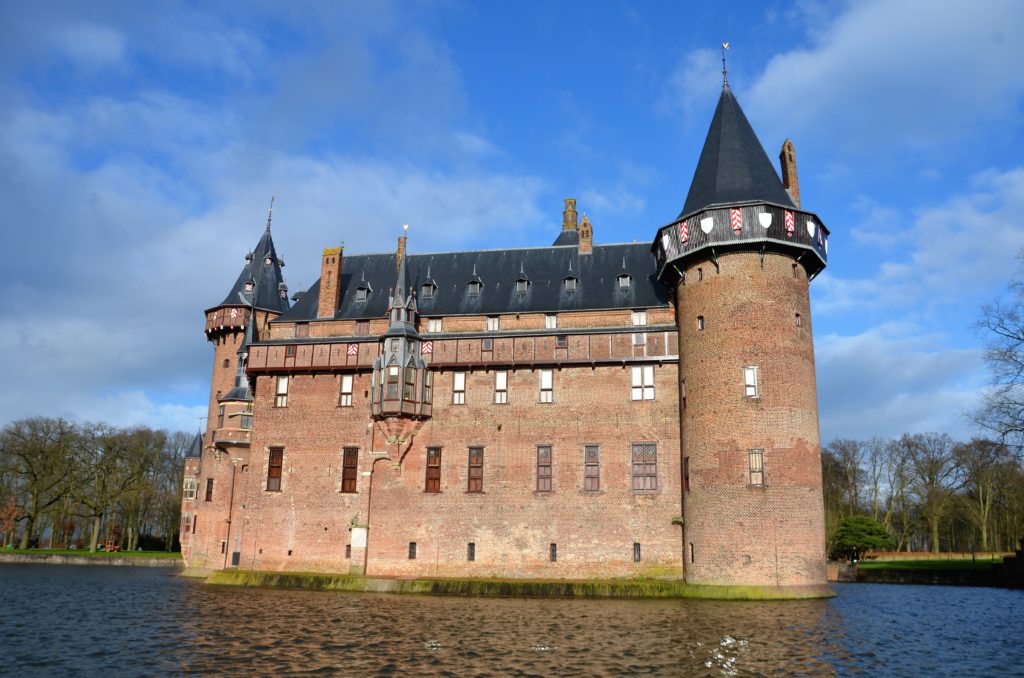
Contributed by Cosette from KarsTravels.
De Haar Castle is the largest castle in the Netherlands. It’s located in the village Haarzuilens, close to the city of Utrecht. It’s considered one of the most beautiful castles in the Netherlands.
There’s presumably been a house or castle on this spot since the 13th century. In the 15th century the Zuylen family became the owners of the castle. In the 19th century the castle resembled a ruin, so Baron Etienne van Zuylen van NIjevelt decided to rebuild it. Architect Pierre Cuypers designed a neo gothic style medieval looking castle. Following the outlines of the old castle. They included all sorts of modern comfort for that time, such as hot and cold running water and central heating.
Even though the Van Zuylen family doesn’t own the castle anymore, they still reserve the right to reside at the castle one month a year.
You can reach the castle by car or with public transport. They have their own parking lot, which costs €6.00. With public transport take bus line 127 to Breukelen from Vleuten train station and exit at stop Brink, Haarzuilens. Visiting the castles gardens costs €7.00 for adults and €5.00 for kids 4 till 12. Visiting the castle, including the gardens, costs €18.00 for adults and €12.50 for kids 4 till 12.
You can visit the castle on your own. There are guides in every room to tell you about the castle or on a tour as a group. Take at least about 2 hours for the castle, more when also visiting the gardens.
The castle is extra magical and fairytale like during Elfia. A yearly event held at the castle grounds. The largest outdoor costumed event in Europe.
Prague Castle, Czech Republic

Contributed by Veronika by Travel Geekery.
The Prague Castle is undoubtedly the most famous castle in the Czech Republic, not only in Prague.
The base of today’s Prague Castle comes from the 8th century, but its main construction started in the 10th century. It took over a thousand years of continually adding and rebuilding of existing structures. The most famous one on the Prague Castle grounds – the St. Vitus Cathedral – was constructed in the 14th century. For nearly all its existence, the Prague Castle served as the seat of Czech princes, kings, and, ultimately, presidents. Even though the style is predominantly Romanesque, the St. Vitus Cathedral, which serves as the main landmark, shows clear features of the Gothic style.
Visitors can roam the courtyards of Prague Castle grounds for free. For an entrance fee of 250 CZK (adults), you get access to the St. Vitus Cathedral, the St. George’s Basilica, the Old Royal Palace, and the Golden Lane. An additional fee of 170 CZK applies for climbing the stairs of the Southern Tower. There are guided tours on offer too, one in English costs 100 CZK.
If you only want to take a quick walk, half an hour is enough. To visit Prague Castle properly, count at least two hours.
Also, there are security frames at the entrance and in peak times long lines may form.
The most convenient way to get to the Prague Castle is by tram no. 22 (and also 23 in summer) – the Pražský hrad stop lies a short walk from the castle.
Conwy Castle, Wales

Contributed by Paulina from UKeveryday.
If you are looking for a fairytale castle that is set in the beautiful scenery in one of the most charming medieval towns in Europe, visit Conwy Castle in Wales. This fortress was built between 1283 – 1289 and the cost of it exceeded all expectations. You will not find a more expensive castle anywhere in Wales.
Beautiful towers, views of Snowdonia National Park and River Conwy makes this castle one of the most stunning in the whole country. This 13th century building is open seven days a week between 10 am and 5 pm. There is a fee to visit the castle, however, exploring Conwy Town Walls is free.
It is worth planning a nice day out if you want to visit Conwy. You will need about 2-3 hours to explore the castle, but there is so much to do in this area that you will want to stay in this Welsh town much longer.
Ptusjki Grad, Slovenia
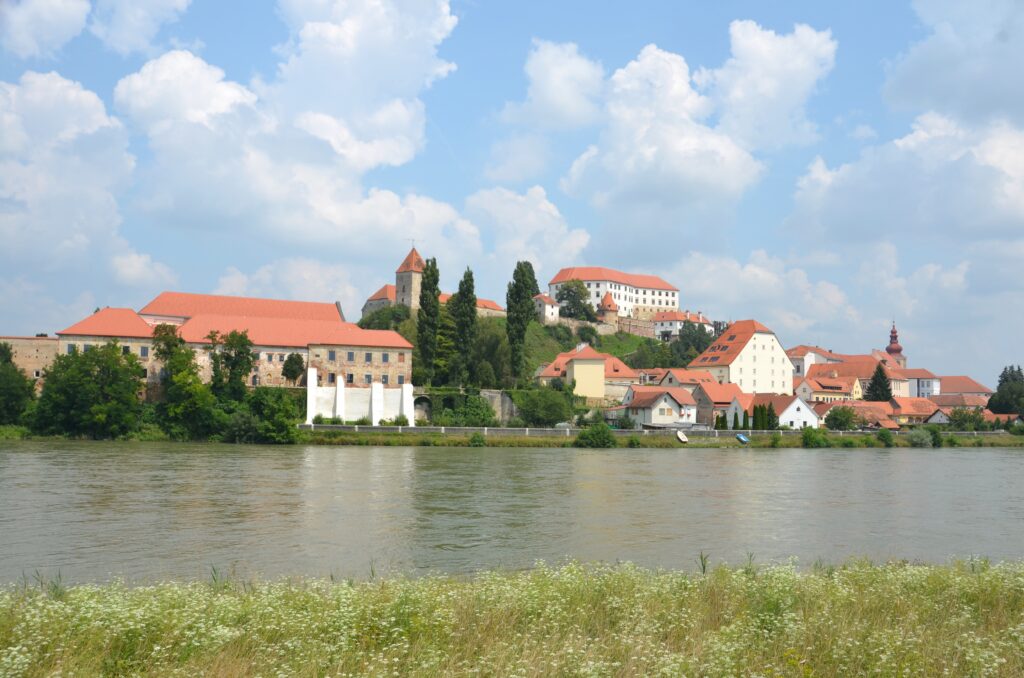
Contributed by Cosette from KarsTravels.
Ptuj castle is in the town of Ptuj in Eastern Slovenia, not that far from Maribor and the Croatian border. The castle can be seen above the town, when standing on the other side of the river Drava, looking really fairytale like. It’s an iconic and prominent landmark in the town of Ptuj.
The castle was first built in the 11th century as a medieval stronghold to defend against the Hungarians. After that it was used in the Turkish invasions, with the end of these invasions, the defensive character of the castle was lost. In the 16th century the castle got its current look. After 1945 the castle was nationalized and became a museum of regional history.
You can visit the castle on your own, there’s an exhibition on the Ptuj carnaval with the “Kurent”. Which is really interesting. The castle is in baroque style on the inside and has a beautiful Renaissance style courtyard. You’ll have mesmerising views on the river and the old town of Ptuj from the castle. Ptuj is the oldest city of Slovenia.
The castle is 130 kilometers/81 miles East of Ljubljana. Tickets cost €8.00 for adults, seniors €7.00 and kids below 16 are €3.00. Ptuj castle can best be reached on foot via Grajska ulica and a wooden covered walkway. Take at least 2 hours for a visit to the castle. Guided tours are offered and cost extra. There are guides in Slovenian, English and German.

Chȩciny Castle, Poland

Contributed by Jakub from tymrazem.
Chęciny is a small town located near Kielce (Świętokrzyskie Province, Poland). The ruins of the royal castle dominate it. The castle is the most famous tourist attraction in Chęciny.
You can get to the castle in two ways. The first path leads from the town, and the second from the parking lot located on the southern side of the castle hill.
Admission to the castle is paid. Adults will pay PLN 17 and children PLN 13. It is open every day from 9 a.m. and, depending on the season, it is open until 4 p.m. or even 7 p.m.
Inside, you can learn more about its history, buy souvenirs and probably the most important attraction – climb the tower, which offers an amazing panorama of the area. You can see Kielce located north of it or the surrounding reserves – Miedzianka and Zelejowa.
During your visit to the Royal Castle in Chęciny it is also worth visiting the city itself. You will find the Market Square, a beautiful church, two monasteries, a former synagogue, and in the eastern part of castle hill also a forgotten Jewish cemetery.
Caerphilly Castle, Wales

Contributed by Cath from Wales with Kids.
A fairytale castle to visit in Europe is Caerphilly Castle. Located in Caerphilly, a town in South Wales less than 30-minutes from the Welsh capital, Caerphilly Castle is the second largest castle in Britain after Windsor Castle.
Built in the late 13th-century by Gilbert de Clare, Caerphilly Castle introduced concentric castle defenses to Britain, and it stood on the island in the middle of the artificial lake ever since.
Caerphilly Castle can be visited from Cardiff either by car or by train. Both journeys take less than 30-minutes and the walk from the train station to the castle is a few minutes.
There is a fee to enter the castle where you can explore the Great Hall (provided there is no wedding taking place), the gatehouse towers, the battlements, and more. Did you know that the leaning tower at Caerphilly leans to a greater degree than the Leaning Tower of Pisa? Make sure to go see it and the knight holding it up.
Caerphilly also has something other castles in Wales do not, a dragon’s lair where you will find Dewi and Dwynwen and their babies. The dragons started arriving in 2016 and the family has grown ever since. And behind the castle is Gilbert’s Maze, a wooden maze that provides fun for those who visit the castle.
You can expect to spend at least one hour at Caerphilly Castle. There is a small exhibition and video presentation at the site. There is no parking directly at the castle, but there is a supermarket car park across the road.
So, if you are looking to visit a fairytale castle in Wales, make sure to visit Caerphilly Castle.
Blarney Castle, Ireland

Contributed by Cath from Travel Around Ireland.
One of the best fairytale castles to visit in Europe is Blarney Castle in Ireland. Blarney Castle is located in County Cork, a short drive of less than 20 minutes from Cork City, which you can do independently or with tour groups. A medieval castle dating from the 15th century, the original castle was wooden and built in the 12th-century.
Blarney Castle is also one of Ireland’s most popular castles, visited by thousands of visitors each year, many of whom come to do one important thing: kiss the Blarney Stone. This famous part of the castle is located on the top floor of the castle, and it is said that those who kiss the Blarney Stone will be bestowed the gift of the gab and never be lost for words again.
But the stone is not all there is to see and do at Blarney Castle. The castle is surrounded by extensive gardens that include a fern garden, fairy garden, poison garden, and two waterfalls. There are also several walks around the grounds including a lake walk and a woodland walk.
The Stable Yard houses the Stable Yard Café where you can get a light meal and refreshments, and you can see old, historic vehicles and horse carriages in the yard area.
With a rich history, famous stone and glorious gardens and grounds to explore, you can expect to spend at least half a day at Blarney Castle. This fairytale castle in Ireland is a must if you are in Cork or visiting the southern half of the country.
Château de Chambord, France
Contributed by Lisa from Waves and Cobblestones.
The Château de Chambord is a quintessential fairytale castle, and it is one of the most spectacular châteaux in France’s Loire Valley. This castle is a gorgeous example of French Renaissance architecture. Its construction began in 1519 for François I, and many French kings resided here over the centuries.
Château de Chambord is surrounded by elegantly manicured French formal gardens and an extensive forested park, which was used for grand royal hunting parties. The castle has been honored with a UNESCO World Heritage Site designation.
The Château de Chambord is a sprawling castle –it contains over 400 rooms, more than 80 staircases, and is decorated with over 4000 pieces of art! More than 60 of the Château’s rooms are open for the public to explore. You probably won’t be able to see everything, but plan to spend several hours on your visit to this castle.
You will certainly want to see the Château’s highlights. At the top of your list must be the stunning double helix staircase, which was inspired by Leonardo da Vinci. Take a step back in time as you wander through the historically decorated 18th century apartments. Be sure to take some time to enjoy the delights of the formal gardens, which are framed by the waters of the Cosson River.
You can take a self-guided tour of the Château and gardens for €14,50 (note there is an additional fee for parking). Guided tours are currently suspended, but for €6.50 you can rent a HistoPad and access interactive maps, a visitors’ guide, and audio commentaries.
Castel Sant’Angelo, Italy
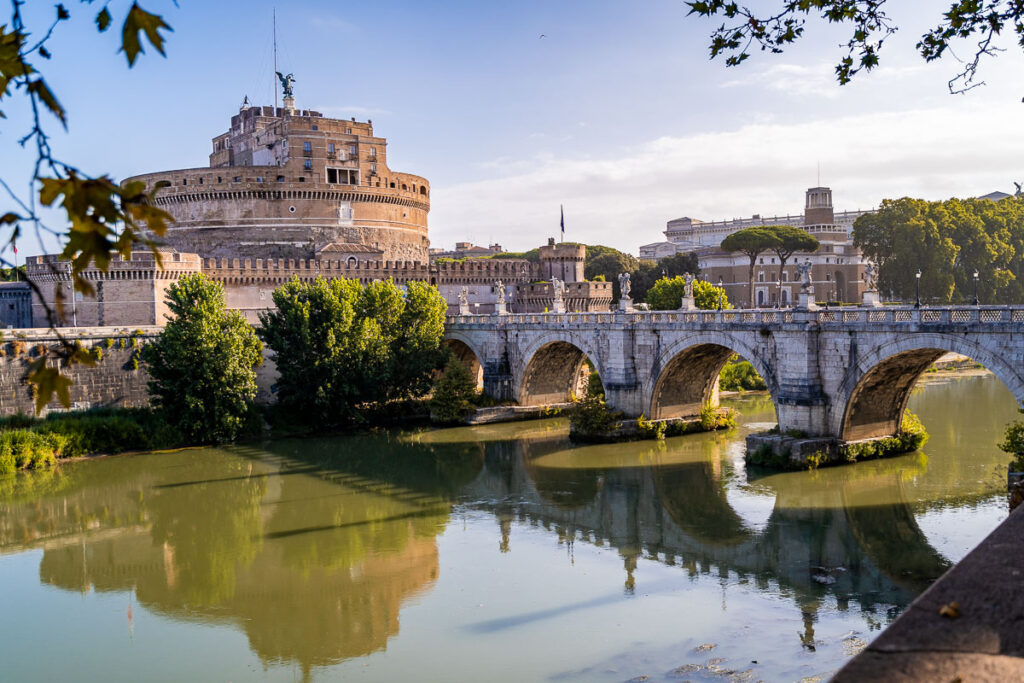
Contributed by Kriszti from She Wanders Abroad.
If you’re looking for fairytale castles in Europe, you can’t miss visiting Castel Sant’Angelo.
This imposing fortress is located in Rome, Italy, on the right bank of the Tiber River. The castle was originally built as a mausoleum for the Roman emperor Hadrian in the 2nd century AD. Later, it was used as a fortress and a palace by successive rulers of Rome.
The castle’s most distinctive feature is its cylindrical shape, which is unusual for a castle. The exterior of the castle is decorated with statues of angels, and the interior is lavishly decorated with frescoes and tapestries. You can also visit the underground chambers, where you’ll find the emperor’s tomb.
What’s even more special about the castle is that you can go up to the top from where you can soak up a breathtaking panoramic view of Rome and the Vatican City.
Castel Sant’Angelo is open to the public and it’s one of the must-visit attractions in the city, even if you have only one day in Rome. Tickets start from €16.00 and you can either book them in advance or buy them on the spot. The museum inside is not that big, so you only need an hour or two to explore everything.
Predjama Castle, Slovenia

Contributed by Marjut from The Smooth Escape travel blog.
Located in southwestern Slovenia, Predjama Castle is an awe-inspiring Renaissance castle dating back to the 13th century. What gives this castle a really unique appearance is the fact that it is built inside the mouth of a large cave, in the middle of a 120-meter-tall cliff. It is the largest cave castle in the world and is often considered one of the most beautiful places in Slovenia.
You can marvel at the castle from the outside for free. If you’d like to see its interior, you’ll have to pay a fee of €15.80 and either take a guided tour or a self-guided audio tour.
Inside the castle, you’ll have the opportunity to explore the living quarters, the armory, secret tunnels, dungeons and even an eerie torture chamber. During the summer months, it is also possible to visit the cave underneath the castle. You can expect to spend about 1-2 hours here if you decide to visit the interior of the castle. Otherwise, 30 minutes is enough.
Many people combine their visit to Predjama Castle with a trip to the nearby Postojna Cave, which is one of the most famous tourist attractions in Slovenia. Here you can take a relaxing train ride through a giant underground cave system and admire ancient stalactites and stalagmites.
Castillo de Colomares, Spain

Contributed by Cristina from My Little World of Travelling.
If you are visiting Malaga, you will love discovering Castillo de Colomares, a hidden gem located in Benalmadena Pueblo.
Castillo de Colomares is a monument in the shape of a castle that was built to remember the life and adventures of Christopher Colombus. In this unique castle, you will find different types of architecture (Byzantine, Romanesque, Gothic and Mudejar) that will make you fall in love with it.
Although it isn’t very big, you can spend up to an hour if you follow the guide provided in the ticket office, which has a bit of history about this monument, or you can also take photos.
The entrance fee is €3, and you can visit the castle by taking a train from Malaga city centre and then walking or by car.
My biggest advice is to visit it early in the morning and on a weekday, to have the place to yourself, especially if you want to take pictures. It isn’t a place that many tourists know about, but due to its small size, you may find it crowded at times.
Pena Palace, Portugal

Contributed by Mary from Be Right Back by Mary.
Pena Palace is located in Sintra, a small town which is just a short 40 minute train ride from Lisbon. The Palace is an out-of-this-world construction which seems to have come straight out of a Disney movie. The Romanticist castle, surrounded by gardens and lakes, was the summer residence of the King of Portugal. It is now classified as a World Heritage Site by UNESCO and is definitely a unique visit which you should add to your Lisbon itinerary.
You can choose to visit only the park and the castle’s terraces (Tickets are €7,50) or the inside as well (Tickets are €14). The visit itself isn’t guided although you can book a guided tour from Lisbon. The visit of the terraces takes about one hour and you can spend as much time as you want in the park. Another hour will be needed if you plan on visiting the inside of the castle.
Note that the Palace is located a few kilometers from the train station so you will need some transportation to get there. There are lots of tuktuks by the train station who are ready to take you there (around €10 per person).
Lednice-Valtice, Czech Republic

Contributed by Kami from My Wanderlust.
A UNESCO-listed Lednice-Valitce complex, located in the very south of the Czech Republic near the border with Austria, is a true gem known also as “the garden of Europe”. This is the largest European park created by a man and actually consists of two properties: the Lednice palace and the Valtice chateau, located some 8 km apart. The complex is connected to the Liechtenstein family who has been present in the area since the 13th century but started creating the eerie space in the 17th century. Today you can visit both properties, the fairytale-alike Lednice palace and the Baroque Valtice chateau (that is also home to the Wine Salon of the Czech Republic).
It’s better to book your tickets in advance, especially in the summer season. Besides the beautiful properties, you can wander around stunning parks and see other attractions the complex hides, such as the artificial ruins or the minaret. Visiting the Lednice-Valtice complex is rather easy, the place is located 50 km away from Brno (the second-largest city in the Czech Republic) and 90km north of Vienna (the capital of Austria). You can easily get here by car, public transport is available too. You should reserve at least half a day to visit both properties as well as to explore the complex grounds.

St. Michael’s Mount, England

Contributed by Sarah from Cornwall’s Best.
The castle of St Michael’s Mount in Cornwall has been an important trading post since the first century AD and is one of the most distinctive castles in Cornwall and indeed Europe! There has been a chapel here since 1044, and the castle has seen its fair share of battles – including during the Civil War. The castle has been owned by the St Aubyn from 1660 until 1964 when the property was given over to the National Trust, although the family have a 999-year lease to live in the castle and operate viewings of the public rooms at the Mount.
The castle is linked to the mainland town of Marazion by a tidal causeway, which means that opening times depend on the tide. There’s free entrance to National Trust members, otherwise, it’s £14 for adults and £7 for children. Be sure to download the free audio guide which has great details on what to see at the Mount. Also ensure you see the clock that tells the tide times along with the time of day, a piece of a coat that Napoleon wore at the Battle of Waterloo, and a sofa belonging to Queen Victoria.
Schwerin Castle, Germany
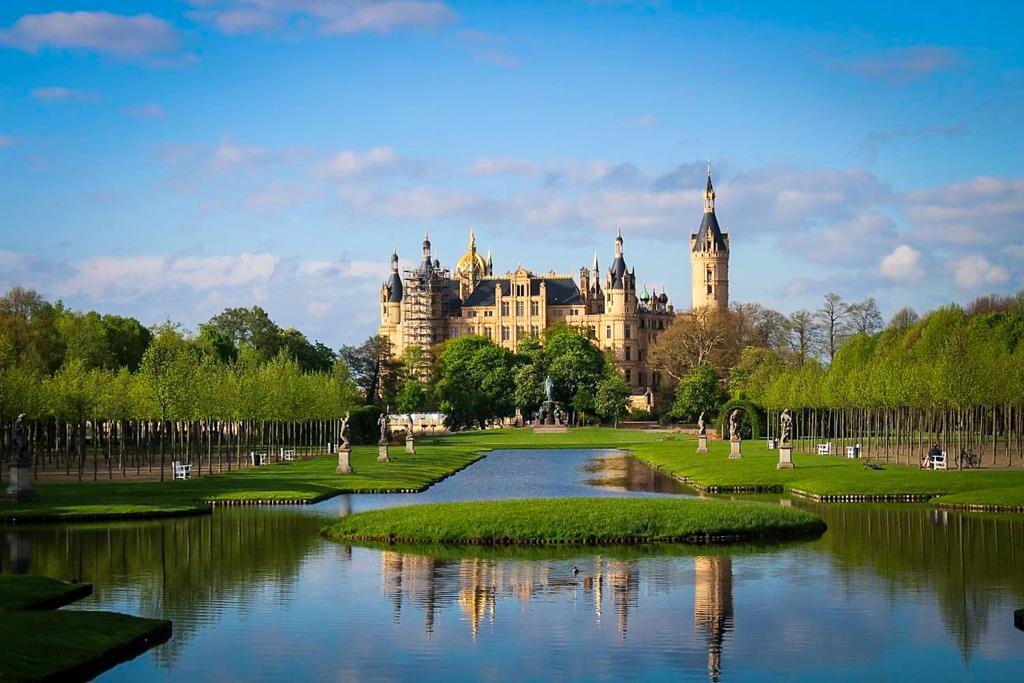
Contributed by Matthias & Kent from Destination The World.
The magnificent Schwerin Castle (Schloss Schwerin in German) is often nicknamed Neuschwanstein of the North. And no wonder! It can certainly compete about the title of the most pretty castle in Germany.
Located on its own island in the small town of Schwerin, this castle is truly spectacular. It is the former residence of the dukes and grand dukes of Mecklenburg and Mecklenburg-Schwerin. For centuries the castle was the main seat of this ruling family. Today, parts of the castle serve as the seat for the state parliament for the German federal state of Mecklenburg-Vorpommern.
You enter the castle grounds via a bridge from the city. Take a stroll in the huge park for great views of the castle before you go inside. General admission to the castle is €8,50, while the palace ground and park is free of charge. You can rent an audio guide if you wish. Although the whole castle is majestic, it is best seen from the outside. That’s where it is at its most beautiful.
You can reach Schwerin on a day trip by train from Berlin or Hamburg. Travel time varies between 1 to 3 hours.
Don’t miss a stroll through the cute town of Schwerin as well. While you are there. Among cute houses and lakes, you can also visit the Stately Art Museum of Schwerin. It is located next to the castle.
Bratislava Castle, Slovakia

Contributed by Linn from Brainy Backpackers.
Towering on a hill above the Danube River and Slovakia’s underrated capital city you can spot Bratislava Castle. Stunning and wise from history, it was originally built in the 8th century but rebuilt several times, the latest in the mid-1900s.
Inside, you can visit the Slovak National Museum and Museum of History where you can learn about the society in Slovakia from all the way back to the Middle Ages. There is also an interesting section from the Second World War. There is also an art exhibition on the top floor. Then there is the treasury where you can get an insight into local silver and goldsmith works.
The admission fee for all the castle’s exhibitions and treasury is €10 for adults. If you want to hire an English guide, it is €15 per group.
The gardens around the castle are free to visit and offer sweeping views of the old town and the Danube River and is truly one of the best things to do in Bratislava. For seeing all the exhibitions, the treasury, and the gardens, it is recommended to spend 2-3 hours.
Elizabeth Castle, Channel Islands
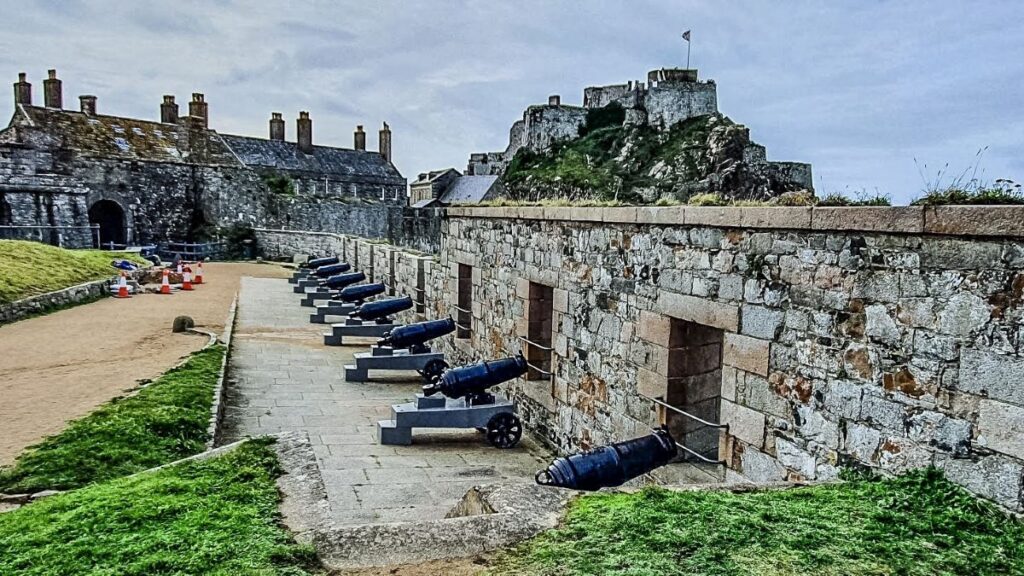
Contributed by Coralie from Grey Globetrotters.
Visiting the stunning island fortress of Elizabeth Castle in the British Channel Island of Jersey is just like stepping into a fairytale. With Royal connections and a turbulent history to discover, visiting Elizabeth Castle is one of the best things to do on a trip to Jersey.
Built by Sir Walter Raleigh at the dawn on the 17th century, on a tiny islet in the Bay of St Aubin, the castle was named in honour of Queen Elizabeth I. It was designed to protect Jersey’s south coast and main harbour from attack by neighbouring France.
To reach the island, you can take a 20 minute walk along the causeway that is revealed twice a day as the tide goes out or take a fun ride in the amphibious vehicle that makes the trip whether the tide is in or out! The ferry is included in your admission charge.
The best way to get the most from your trip is to join the free tour with a volunteer guide from Jersey Heritage. You’ll learn all about the castle’s dark history, how the garrison lived on the island, and how the castle was commandeered by the German forces who occupied the Channel Islands during World War 2. Don’t forget to check out the Hermitage Chapel, the breakwater and the German bunkers too.
Time your visit right, and you might get to see a military re-enactment or one of the cannons being fired too.
Bojnický Zámok, Slovakia

Contributed by Manouk from Groetjes uit Verweggistan.
Bojnice castle (or Bojnický zámok) is a true fairytale castle. It is surrounded by water and we even saw a deer walking by the castle. Could it be more magical?
Slovakia is home to many beautiful castles, but Bojnice castle is the most magical and most beautiful. It is hard to imagine this used to be a wooden castle. It was first mentioned in 1113. The castle had many owners who made all kinds of changes to it. In 1852 the castle was owned by Jan Fratisek Pálffy, who decided to make it the romantic castle it is today.
Nowadays you can visit the castle with a guided tour. Only one tour per day is in English, but fear not: you can also join the Slovak tour with a written explanation in English. The entrance fee is around 11 euros per person.
After visiting the castle it is possible to have a stroll in the city of Bojnice. It is also possible to visit the zoo or the birdshow next to the castle.
Linderhof Castle, Germany

Contributed by Diana from The Globetrotting Detective.
The charming Linderhof Castle is situated in Bavaria in the South-East of Germany. This lovely fairytale palace, built in the 19th century, is one of the glamourous and dreamiest royal castles of the infamous ‘Mad King’ of Bavaria, Ludwig II, next to Neuschwanstein and Herrenchiemsee.
As for Linderhof, Ludwig’s dream was to build a palace similar to the Palace of Versailles in France and it meant to mirror his own fantasy world.
Both the exterior and interior design of Linderhof are luxurious and awe-inspiring. The best part is when you are in the sparkling Hall of Mirrors where you will be blown away by the endless reflections of mirrors.
Stunning gardens with beautiful flowers and plants, impeccably maintained parks with evergreen hedges, cute littles lakes with ducks, green forests, and alpine mountains will make you feel part of Ludwig’s fantasy world.
It is located only 95 km from Munich. That makes it an awesome day trip from Munich. You can easily and quickly get to the Linderhof Palace either by public transport or by car.
Strolling around the grounds of the palace does not require any ticket. Only if you enter the palace and the park buildings, you need a ticket. The entrance fee in the Summer season for the palace and the park buildings is free of charge under the age of 18. As for adults, the ticket costs €10. The Royal Lodge is an additional €2.
The best time to visit the Linderhof Castle is Summer when the forest surrounding the palace is lush green and the park is full of colorful flowers. However, you can also visit the palace in Winter when the price of the ticket is only €9.
That Wrap’s Up Our Castles in Europe Article
Europe has a lot of beautiful fairytale castles worth your time. There’s a specific article on fairytale castles in France.
Like it? Pin it!

Like it? Pin it!

Like it? Pin it!



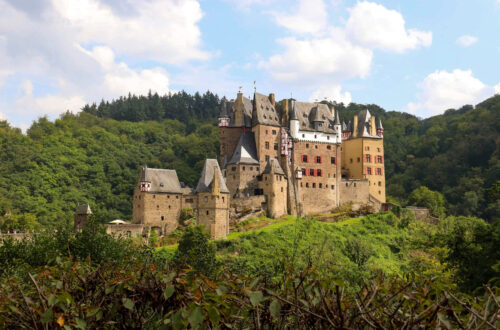
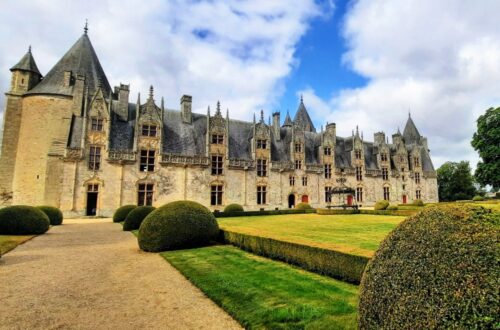
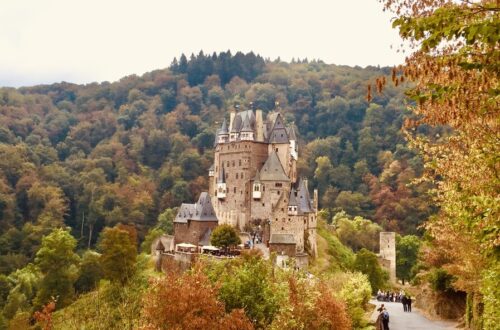
3 Comments
Lisa
Lovely article — so many gorgeous castles. Defintiely the castle Burg Eltz is just what you would picture in your head for a fairytale castle. Thanks!
Rob + Ann @TravelLatte
Wow! We are familiar with many of these castles, but never realized how many astounding castles there are in the Czech Republic. We’ve never been, and now want to go even more! Thanks for sharing.
Anna Schaeffer
I love castles! Great post! What I learned is…Germany has some BEAUTIIFUL castles!